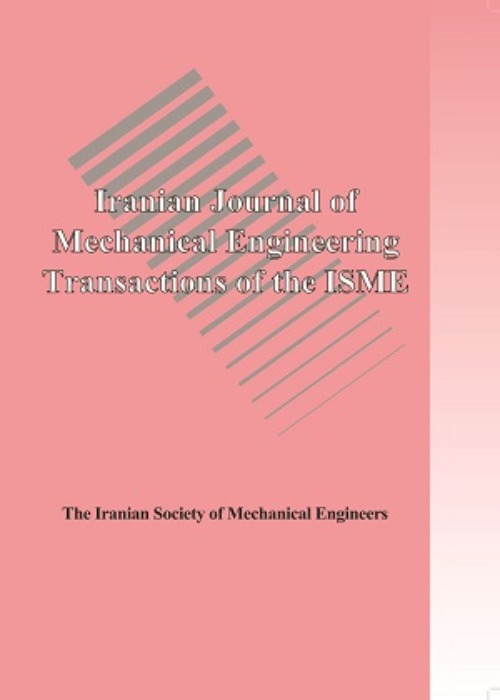فهرست مطالب
Iranian Journal of Mechanical Engineering Transactions of ISME
Volume:8 Issue: 2, Mar 2008
- 98 صفحه،
- تاریخ انتشار: 1388/01/09
- تعداد عناوین: 5
-
-
Pages 6-25Dynamic modeling of the lower extremity exoskeletons for assisting paraplegic patient’s mobility has been addressed in this paper. Three distinct phases which manifests to three different dynamic models have been identified for anterior-posterior motion analysis. Design of the proper actuators to compensate the inertial effects of the exoskeleton, joint stiffness and damping torques are estimated using uncertainty analysis. Simulation results show that the anthropometric design of the assistive system was achieved when the mass and inertia of the exoskeleton leg segments are increased up to 60% of the corresponding human leg segments. A dynamic model based on CGA data employing neuro-fuzzy inference system with an optimum distribution of the membership functions and minimum fuzzy rule bases was introduced for control purposesKeywords: Lower-extremity, Exoskeleton, paraplegic, Dynamic, Uncertainty, ANFIS
-
Pages 26-40This research presents a semi analytical solution of finitely long, simplysupported, orthotropic, piezoelectric, radially polarized, shellpanel under pressure and electrostatic excitation. The general solutionof the governing partial differential equations are obtained bythe method of separation of variables. The displacements and electricpotential are expanded in appropriate trigonometric Fourier seriesin the circumferential and axial coordinate to satisfy the boundaryconditions at the simply-supported circumferential and axialedges. The governing ordinary differential equations are solved bythe Galerkin finite element method. In this procedure, the quadraticshape function is used in each element. Numerical examples are providedfor typical external pressure on outer surface of a single layerpiezoelectric panel.Keywords: linear piezoelectric, finitely long, Cylindrical panel, orthotropic, radially polarized, simply-supported
-
Pages 42-58Design and synthesis of a nonlinear non-minimum phase supersonic flight vehicle longitudinal dynamics control for g commands output tracking are presented. The non-minimum nature of the resulting input/output pair necessitates using a modified switching manifold in sliding mode control theory. Dynamic sliding manifold is designed to compensate for unstable internal dynamics of the system associated with the coupling between the moment generating actuators and the aerodynamic forces on the flight vehicle. The employed method is simple to implement in practical applications and enables the sliding mode control design to exhibit the desired dynamic properties during the entire output-tracking process independent of matched perturbations and accommodates to unmatched perturbations. Results of simulations are presented to demonstrate the performance, robustness, and stability of the considered autopilot.Keywords: Non-minimum Phase Systems, Internal Dynamics, Dynamic Sliding Mode, Disturbance
-
Pages 59-79In ground vehicles, three-axis magnetometers may be corrupted by both soft- and hard-iron disturbances. Therefore, it may not be possible to achieve qualified headings without online calibration of this magnetic system. First contribution of this paper is focused on improving the order of persistent excitation of the squared signal matrix through incorporation of a direction cosine matrix in estimation model. As the main contribution, a fuzzy change detection scheme for adjusting the length of data sliding window of blockwise least square (BLS) algorithms is presented in the framework of on-line estimation of system parameters under both abrupt and gradual changes. This is called fuzzy variable-length sliding window (FVLSW) BLS. Two change detection indices including generalized likelihood ratio and averaged parameter estimation errors together with their changes are considered as inputs of the fuzzy system. The defuzzified outputs consists a forgetting factor in order to place more emphasis on the recent data, and two adjusted lengths of data history windows.Simulations and real experiments revealed that the proposed approach has superior performance with respect to the latest variable-length sliding window (VLSW) BLS estimation algorithm. The superiority is more significant when the measurement noise power is substantial.Keywords: fuzzy change detection, persistent excitation, vehicle navigation, least square, online calibration
-
Pages 80-97The volute of a squirrel cage fan controls the flow field through the rotor and therefore the complete fan. Performance tests on fans with four rotors of the same diameter but with different widths, inside two different volutes showed that larger volute widths flatten the fan characteristics curve and allow a larger maximum volumetric flow into the fan. When the volute width is fixed, the performance curves closely overlap and the rotor width only changes the maximum flow rate. The velocity profiles after the rotor were measured using laser Doppler anemometry for four different fans. They show that in each of the four volute/rotor combinations, the flow out of the rotor is not uniform at different peripheral angles. This pattern changes with volute width and at different operating conditions. At angular positions closer to fan exit where the cross section is larger and the volute resistance is smaller, more flow exits the rotor. This flow has a shorter path inside the volute before it reaches the fan exit and therefore a higher efficiency ensues.Keywords: Squirrel cage fan, laser Doppler anemometry, rotor width, volute, fan performance, velocity profiles


